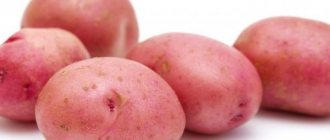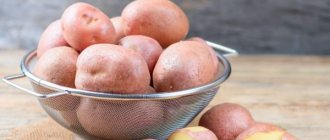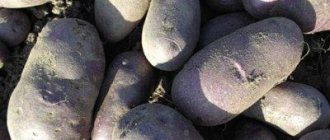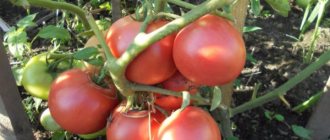Description of the potato variety Limonka and photos of tubers
Limonka is a Dutch variety. Potatoes have a thick, tall stem and dense, spreading bushes with dark green leaves. Limonka blooms with small white or slightly pink flowers.
The tubers are medium in size, similar to a pear. The weight of one potato is 70–120 grams. From one bush you can collect up to 20 tubers. The color of the peel is yellow, as is the color of the inside of the fruit. This is where the name of the Limonka variety comes from. The unequal-sided potato is strewn with pink eyes. Because of her bright colors, she is also called Picasso or Little Red Riding Hood.
The taste of the vegetable is sweet and juicy, but if it has to survive drought, it becomes a little tart. When cooked, the tubers almost do not fall apart. The amount of starch in Limonka does not exceed 10% - this is a small figure compared to other varieties.
This medium-late variety ripens 80–100 days after planting - late August-early September, and the tops die off at about 150 days. Once all the tops have dried, harvesting is completed to avoid possible soil diseases.
Due to uneven ripening, potato harvesting may take two weeks.
The Limonka potato variety is not capricious; the rules for caring for it are, as a rule, minimal. It grows in any soil and is suitable for planting in different regions. Potatoes have fairly high winter hardiness. The yield of Limonka may fluctuate at first, but already 8–9 years after the first planting, the amount of harvest stabilizes and reaches fairly high numbers.
Limonka potatoes have a yellow tint to the peel and pulp, as well as pink eyes.
Table: advantages and disadvantages of the variety
| Advantages | Flaws |
| Low losses during storage | Susceptible to late blight |
| Can be stored for a long time without sprouting | Susceptible to leafroll virus |
| Winter hardiness | Without fertilizers and watering, the taste deteriorates |
| Easily tolerates drought | Uneven ripening |
| Soil quality has almost no effect on yield | Fruits are unequal |
| Low exposure to tuber scab and late blight | Requires large areas when planting |
| Immune to nematode and cancer | |
| Low starch content (10%) | |
| Excellent transportability |
Advantages and disadvantages
The unpretentious potato variety Limonka has various advantages and is therefore planted in many summer cottages:
- perfectly stored in winter without loss of taste;
- has an elegant and attractive appearance;
- tolerates temperature changes well and is resistant to changes in humidity;
- perfectly transported over long distances;
- Resistant to late blight of tubers, scab, potato nematode.
The disadvantages of the Limonka variety include sensitivity to leaf blight.
Landing
Limonka potatoes, although unpretentious, require some attention. When choosing a site for planting, avoid land where tomatoes, beets or cucumbers have previously grown. seed tubers in soil where perennial grasses, lupines, winter crops, legumes, annual grasses or flax grew.
It is important to choose only high-quality tubers for planting, free from stains, rot and other defects.
It is not necessary to germinate potatoes before planting. However, if you want to get an early harvest, then Limonka needs to be germinated at a temperature of 12–15 degrees about a week before planting. By planting sprouted tubers, you will receive your first harvest 20 days earlier than usual. Large potatoes are planted cut. Make sure that both halves have approximately the same number of eyes.
Video: preparation (processing) of seed material before planting
Before planting, it is advisable to treat the planting potatoes with Epin or Zircon to stimulate growth and flowering, as well as increase resistance to diseases. The processing rules are described in detail on the packaging, but, as a rule, 1-2 drops of Epin are diluted in 100 ml of water, and Zircon - in 300 ml. Soaking lasts from 8 to 20 hours.
Potato Limonka loves space
Video: when and how to plant potatoes correctly
Be sure to take into account the free distance between the bushes when planting Limonka potatoes. Due to their spreading nature, the spaces between holes should be approximately 0.5 m long from each other. If this distance is not maintained, the bushes will interfere with each other and block sunlight, which can cause the plant to die. The depth of planting potatoes depends on the quality of the soil. If it is clayey and heavy, then you need to bury the tubers to a minimum, 20–30 cm.
Video: a method of planting potatoes to obtain a high yield
Planting and caring for potatoes
Preparing the soil for planting
Limonka does not require any special techniques different from growing other varieties.
The soil for planting potatoes is prepared in early autumn. This crop can be planted in one place for many years. There are several techniques, depending on the condition of the soil in the area allocated for potatoes:
- If potatoes are planted in virgin soil, first mow the grass and lay it out in a thick layer on the site of the future potato beds. One condition is that the resulting hay should not contain seeds. Over the winter, under a thick layer of such mulch, the remaining grass and roots should rot. In the spring, the grass left over from the soil after winter is collected with a rake. Scatter wood ash over the surface at the rate of 1 liter per 1 m2. The site is dug up with half a shovel and the roots of the weeds are removed.
- After harvesting, the developed area is cleared of remnants of tops and grass, which are raked and burned. Scatter humus or compost over the surface at the rate of 1 bucket per 1 m2, stove ash 1 liter per 1 m2, loosen with a cultivator or dig shallowly, half a shovel deep. In the fall, it is permissible to add fresh manure and bird droppings to the soil before loosening. The entire area of the plot is sown with white mustard or rye. In the spring, they pass again with a cultivator or shovel, embedding the remains of green manure into the soil. If the potato crop area is small, you can process it with a flat cutter, without digging.
Preparing seed tubers for planting
Tubers selected for planting should be of medium size. Before planting, large potatoes are cut into several parts, making sure that the number of eyes on each is equal. To disinfect planting material, a month before planting, potatoes are soaked in a bright pink solution of potassium permanganate with the addition of 1 tablespoon of copper sulfate per bucket of solution. It is better if the water for soaking is warm, about 40 o C. After 15 minutes, the potatoes are removed from the solution and washed with cold water. The dried tubers are laid out in a cool place in the light for germination. After 20 days, small sprouts appear in place of the eyes. 10 days before planting, the tubers are transferred to boxes, layered with damp newspapers and put in a dark, warm place for root germination.
The most favorable time for planting potatoes is the end of April - the beginning of May, when the buds begin to bloom on the birch tree. The soil temperature at a depth of 10 cm should not be lower than 8 o C.
Limonki tubers with sprouts ready for planting
Marking beds and planting
- On the prepared soil, using pegs and string, mark out the beds, drawing furrows. The distance between them is 60 - 70 cm. The ridges are marked in the direction from south to north.
- Holes for potatoes are made along the furrow at a distance of 35 cm.
- Sprouted potatoes are placed in the holes with the sprouts facing up.
- Cover with soil level with the soil level.
- The row spacing is mulched with hay or mowed grass.
The depth of planting of tubers depends on the climate of the planting region. The hotter and drier the climate, the deeper the potatoes are planted. In areas with cool and humid summers, the tubers are laid out directly along the furrow and the soil is raked on them from both sides from the row spacing, forming ridges.
Nuances of care
Caring for plants involves hilling, loosening, and mulching row spacing.
Hill up potatoes two to three times per season.
- If there is a threat of return frosts after the first shoots appear. Plants are covered with soil from the rows along with mulch. The vacated row spacing is again mulched with a thick layer of mowed grass.
- Two weeks after the first, repeating the mulching of the rows.
- Two weeks after the second.
Due to differences in the structure of the bush, potatoes of the Vineta and Colette varieties are hilled differently. The spreading Vineta bush is spread even further to the sides, filling the center of the bush with mulch. The erect Colette bush is covered with soil evenly on both sides. The bush itself will tell you the method of hilling.
Watering and feeding Limonka potatoes is not required if the soil is properly prepared and mulched in a timely manner.
Yield early potato bush Limonka
Diseases and pests characteristic of the Limonka variety
Diseases of the Limonka potato variety
Both varieties, popularly called Limonka, are resistant to potato diseases, except for late blight. But potatoes are weakly affected by it due to their early ripeness. Late blight becomes active in the second half of August. By this time, Limonka, as a rule, has already cleaned up.
https://maja-dacha.ru/kartofel-limonka-opisanie-sorta-foto/https://cemicvet.mediasole.ru/kartofel_limonka__opisanie_sorta_harakteristika_posadka_i_uhod_s_fotohttps://orchardo.ru/21494-kartofel-limonka-opisanie-sorta-foto. html
Care
Approximately 7–9 days after planting the vegetable, caring for it begins. First, you need to very finely loosen the soil using a rake to a depth of 2–3 cm. This will increase the supply of oxygen to the roots and pull out small weeds. If it rains, the soil needs to be loosened again, preventing the formation of a crust that blocks air access to the tubers.
You need to work with the rake very carefully so as not to break the young shoots.
Watering and hilling
Watering is carried out once every 10–14 days, and the amount of water depends on weather conditions: the higher the temperature, the more water the plants need. On light soils, watering is required more often, but in small doses, on heavy soils - less often, but more abundantly.
As soon as the bushes grow to 5–7 cm, they are hilled up and, if necessary, weeded. Repeated weeding and hilling is done after the first buds appear on the tops. This process also helps protect young shoots from night frosts.
To protect against frost, you can also smoke or cover the potatoes with film.
As the potatoes grow, they hill them up, raking soil from the rows under the bushes
Potato feeding
A vegetable grower must fertilize the soil on which potatoes grow. Lemonka loves fertilizers containing potassium, which prevents the development of diseases. In the fall, the soil is fertilized with organic matter, and in the spring, mineral fertilizers are applied to the soil two weeks before planting.
Table: root feeding of potatoes of the Limonka variety
| When is it carried out? | Composition and dose | |
| First feeding | Beginning of tops growth | For 10 liters of water - 1 tbsp. l. urea and 2 tbsp. l. Effecton for vegetables. The dose is half a liter for each bush. This root feeding is done only after rain or watering. |
| Second feeding | During budding | For 10 liters of water - 1 tbsp. l. potassium sulfate and 1 cup of wood ash. Designed to stimulate flowering of potatoes. Dose - half a liter for each bush after watering. |
| Third feeding | During flowering | For 10 liters of water - 1 tbsp. l. superphosphate and 1 tbsp. l. nitrophoska. Dose - liter for each bush. This feeding accelerates the formation of tubers. |
In addition to root fertilizer, dry fertilizing of the soil is also carried out. At the initial stage, in order for the tops to grow faster, half a teaspoon of urea and 170 g of rotted manure are poured under each bush. When the buds appear, add 1 tablespoon of wood ash and half a teaspoon of potassium sulfate under each potato.
Approximately a month before harvest, fertilizing is stopped.
Planting and caring for potatoes
It should be noted that Limonka potatoes are absolutely not picky about soils and easily develop new horizons. Despite the fact that Picasso is common in the Central and Central Black Earth regions, it can be grown in other regions.
Selecting a location, preparing soil and planting material
The variety feels good in both heavy and light soils, delighting with an excellent harvest.
It is best to prepare the soil for planting potatoes in the fall. To do this, you need to dig up the area with the bayonet of a shovel, carefully clearing the ground of weed roots. If the soil is acidic (horsetail, horse sorrel, buttercup, and pikulnik grow on it), in the fall you need to add dolomite flour or lime to it at the rate of one glass per 1 m2. Picasso is very picky about fertilizers. The more competently they are applied, the higher the yields
Therefore, in the spring it is very important to correctly and in the right quantities enrich the soil with useful minerals and organic substances.
Table: soil fertilization before planting
| Soil type | Fertilizer |
| Clayey (loamy) | One bucket of humus per 1 m2 |
| Sandy (sandy loam) | One bucket of humus and clay soil per 1 m2 |
| Peat | One bucket of clay soil, river sand and humus (compost) per 1 m2 |
Mineral fertilizers are applied before digging, regardless of the composition of the soil: 1 cup of ash and two tablespoons of nitrophoska per 1 m2.
The choice of seed must be taken extremely seriously. After all, the success of the future harvest depends on this. It is recommended to carefully examine the tubers. They should be free of signs of disease, clean, undamaged, and the size of a chicken egg. Such seeds are placed in boxes 6 weeks before planting and kept in a bright place at a temperature not exceeding 15 °C. Tubers are planted in early May at a distance of 50 cm from each other. This is done to ensure that the bushes do not intertwine with each other, as well as to prevent the appearance of fungal diseases due to insufficient air circulation. The seeds are buried on the bayonet of a shovel and sprinkled with earth. The soil should be loosened shallowly with a rake a week after planting.
Sprouted potatoes sprout faster
Table: basic care for Limonka potatoes during the period of growth and development
| Top dressing | Hilling | Watering |
| Carry out together with the first hilling. For 10 liters of water 2 tbsp. l. urea, 0.5 liters for each bush. | 1st. When the bushes reach a height of 15 cm. | Do not allow the earthen ball to dry out or crack. |
| When the buds set. For 10 liters of water, one glass of wood ash, 0.5 liters for each bush. | 2nd. Three weeks after the first hilling. | |
| After flowering. For 10 liters of water 2 tbsp. l. nitrophosphate and a glass of chicken manure (cow manure). | Not required |
Lemongrass tolerates drought well, but should not be overused. After all, this will one way or another affect the quality and quantity of the harvest. In the absence of rain for a long time, abundant watering every 10 days is recommended.
Possible diseases
- Late blight. 14–18 days after the appearance of the first shoots, prevention against diseases begins. The first treatment is against late blight. It appears in the form of brown and brown spots that become covered with cobwebs and spread quickly. The result of this fungal disease is dried out shoots that rot in high humidity. To avoid this disease, you need to carefully select potatoes for planting, get rid of excess tops in a timely manner and apply potassium fertilizers.
- Rhizoctoniosis. If a pale coating is noticeable in the place where the stem meets the root, it means that the potato has become infected with rhizoctonia. Dark spots appear on the vegetable itself. This disease actively develops at high temperatures. To avoid it, you need to plant only healthy tubers and harvest on time.
- Ring rot. Damage is caused not only to the leaves, but to the entire vegetable. Infection usually occurs after flowering. Some potato stems are wilting, and the tips of the leaves are being eaten away by dark spots. To prevent the crop from dying, you need to weed the potatoes on time and harvest them only in dry weather.
Photo gallery: diseases of Limonka potato varieties
Gray-brown spots appear on potatoes - this is late blight, which leads to rotting of the tubers
Rhizoctoniosis manifests itself as bright brown spots on the skin of potatoes
Ring rot softens the tuber tissue, which turns into a slimy mass with an unpleasant odor.
Features of planting, growing and care
Growing blue potatoes in your garden is no more difficult than usual. There are care recommendations that promote high yields.
First of all, it is important to select proven seed material. One month before planting, the tubers are germinated in a warm room where the temperature is maintained at +15-+19°C
Soil for potatoes
It is important to think about the landing site in advance. The area should be illuminated by the sun
Preferably southern and southwestern areas. The soil needs to be dug up in the spring and preferably in the fall, to saturate the soil with oxygen. The plant takes root on chernozem, soddy-podzolic soils with neutral acidity. To increase productivity, mineral or complex fertilizers should be added at the time of digging. The culture responds with rapid growth to nitrogen, potassium and phosphorus fertilizers.
Swampy places where water regularly stagnates are not suitable for planting. The soil should be fluffy and loose, in this case the yield percentage is higher.
The plant is planted at a time when the earth is warmed by the sun to +4-+6°C. In Central Russia, planting occurs at the end of April - beginning of May. The growing method can be soil, straw, bags, etc.
The classic option for planting in the ground:
- Furrows are made with a depth of 10 to 15 cm. The seeds cannot be buried, otherwise they will take a long time to germinate.
- Organic fertilizer, such as wood ash, is added to the center of the hole. A layer of earth is poured on top and leveled.
- The distance between potatoes is 25-30 cm.
- A suitable distance between grooves is 30-40 cm.
In cold regions, plantings are covered with film to create a greenhouse effect and protect the plant from possible frosts. The covering material is removed when the seedlings begin to hatch.
After planting, we must not forget about watering the crop.
It is important to monitor the condition of the soil to avoid dryness or excess moisture. Overwatering leads to rotting of the roots, increasing the likelihood of insects
The bushes require increased watering after germination. Then after the buds set and at the stage of flower fall. Weekly sprinkling in small quantities leads to the growth of green mass.
Purple potatoes suffer from leaf blight more than other crops. The plant is actively eaten by the Colorado potato beetle and aphids. They need to be dealt with immediately in order to save most of the harvest. Ways to get rid of diseases and insects can be traditional or using chemicals
It is important to remember that you need to apply insecticides a month before harvesting vegetables. Disease prevention is considered to be the treatment of seed material with disinfecting solutions and compliance with crop rotation.
Weeding and hilling of purple-skinned potatoes is most required during the flowering stage. Additional saturation of the soil with air will benefit the root system of the crop.
Growing and yielding purple potatoes
Potato pests
- Wireworms. These are 3 cm long worms that eat potatoes, making many moves in them. To get rid of wireworms, bait is used: small pieces of potato on a stick are buried in the soil to a depth of 10 cm, and after a day the sticks are removed. A lot of wireworms accumulate on them. For maximum effect, many such traps are made. After this, they begin planting.
- Caterpillars. They lay eggs on the leaves and eyes of potatoes. The hatched caterpillars eat holes in the tuber, thereby spoiling it. To destroy caterpillars, the following chemicals are used: Bitoxibacillin, Dendrobacillin, Entobacterin and Lepidocide, etc.
- Medvedka. She gnaws the roots and stems of plants, “cutting” them off from each other. To combat mole crickets, traps, an infusion of hot pepper, the drug Medvetox, etc. are used.
Photo gallery: potato pests
Wireworms spoil the tuber by gnawing passages in it
Caterpillars lay eggs on the leaves and in the potatoes themselves
A mole cricket bites off a stem from a potato root
Harvest storage
The Limonka variety will lie well if the tubers were not baked in the sun during harvest, did not receive any scratches, and did not touch the tops with late blight. Vegetables that have just been picked should not lie in the sun or wind for more than half an hour. Otherwise, the potatoes will begin to rot during storage.
To store potatoes on the balcony, they are folded into two linen bags and placed in a wooden box. This box is placed in another, slightly larger one. The air gap between the walls of the boxes should be approximately 9–11 cm. This space is filled with some rags. The boxes are also covered on top. This protection allows you to preserve potatoes in frosts down to –15 °C .
Limonka is stored in a dark room (basements, garages, cellars) at a temperature of approximately +5 degrees.
It must be remembered that potatoes turn green and sprout in the light. You can't eat such tubers.
With proper storage, Limonka potatoes will remain in excellent condition until the next harvest, and losses will not exceed 10–12%.
Table: potato diseases that appear during improper storage
| Disease | How to recognize | What to do |
| Powdery scab | Small bumps appear under the skin, then they dry out and crack. |
|
| Wet bacterial rot | Darkening inside the potato occurs due to its mechanical damage. Light gray spots appear first, then they darken. |
|
| Tuber suffocation | This problem occurs due to insufficient air supply to the tubers during growth. | Loosen the soil around the potato bushes more often. |
Where to buy seed potatoes with delivery
The scientific and production association “Gardens of Russia” has been introducing the latest achievements in the selection of vegetable, fruit, berry and ornamental crops into the widespread practice of amateur gardening for 30 years.
The association uses the most modern technologies and has created a unique laboratory for microclonal propagation of plants.
The main task of the NPO "Gardens of Russia" is to provide gardeners with high-quality planting material for popular varieties of various garden plants and new world selections.
Delivery of planting material (seeds, bulbs, seedlings) is carried out by Russian Post.
We are waiting for you to go shopping at the NGO “Gardens of Russia”.
Reviews from gardeners
This potato variety was bred by Dutch breeders. The variety is a late-ripening variety with a growing season of 110-120 days; if cultivation techniques are followed, the potato yield can reach up to 600 kg per hundred square meters, but on average it is about 300 - 400. The weight of marketable tubers ranges from 80 to 140 grams. The bushes of the variety are tall, spreading, bloom white and very abundantly. The color of the tubers is yellow with pink spots, which is a distinctive feature, and this potato cannot be confused with any other. The pulp has a cream color. Picasso is resistant to diseases, except for late blight, but the immune system is strong and one treatment per season will be enough. Potatoes must be hilled. In terms of taste characteristics, this is one of the best varieties at the moment. It stores well, does not dry out, does not rot. I would rate this variety 6 on a 5-point scale.
Lenin19176
https://otzovik.com/review_4384232.html
Two big and bold advantages of this variety: 1. Picasso potato leaves do not really like to eat the Colorado potato beetle, this has been noticed for more than one year, when there is a lot of it on other varieties, then there is half as much on it, and this is constant. The variety is not genetically modified, which excludes its protection from beetles, but for me it’s just not very tasty, like an ordinary rural, old variety. It’s definitely not suitable for frying, but it’s perfect for purees; it cooks very quickly, which saves gas consumption. It’s also not suitable for soups, as it boils completely. 2. Picasso potatoes are much less affected by late blight, which saves you money on chemicals, when late blight is rampant in your neighbors, our potatoes stand green as if nothing had happened. This has been noticed for many years; late blight begins to affect it already when it grows into large bushes, and only in places. At first we treated it for diseases, but for the last two years we haven’t used anything, everything was fine! It keeps well all winter, one drawback is that it is difficult to clean with its pits, and of course the taste, but there are people who like it.
Vikli
https://otzovik.com/review_4495519.html
I really liked the initial harvest of these potatoes; I didn’t even need to apply fertilizer. The potatoes grew clean without disease and had a pleasant taste. So I recommend trying the potatoes.
fyjdt77777
https://otzovik.com/review_4384309.html
Limonka potatoes really have excellent taste and high disease resistance, and are easy to care for. This variety pleases its owners with its productivity and excellent keeping quality. All the more pleasant it is when there are potatoes on the table that did not fall apart during cooking.
- Author: Lana Belyash
Rate this article:
- 5
- 4
- 3
- 2
- 1
(0 votes, average: 0 out of 5)
Share with your friends!
A Brief History of Breeding
The Limonka potato was created in Holland by the company AGRICO UA . An application for its registration in the Russian Register of Varieties and Hybrids was submitted in 1992. In 1995 it was approved for mass cultivation. Admission regions are Central (Bryansk, Moscow, Ryazan regions, etc.) and Central Black Earth (Voronezh, Kursk, Belgorod regions, etc.).
Despite the fact that among the Russian originators there are two companies from the Leningrad region, the variety was not allowed for cultivation in the North-West region. This means that in the Leningrad region Limonka is considered an unregistered variety, and therefore is grown by the manufacturer at his own peril and risk.











